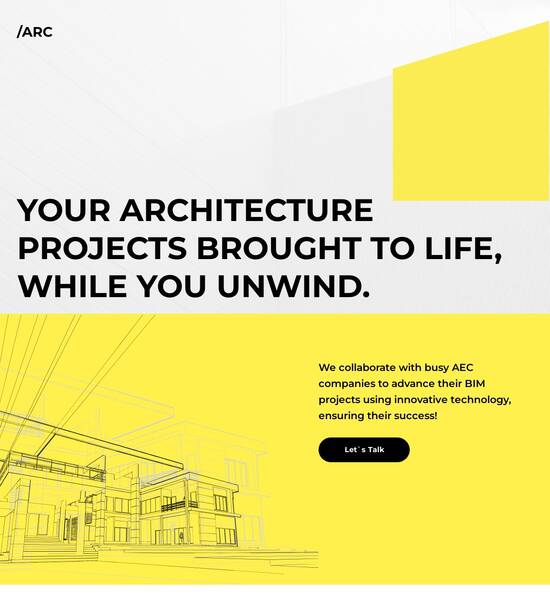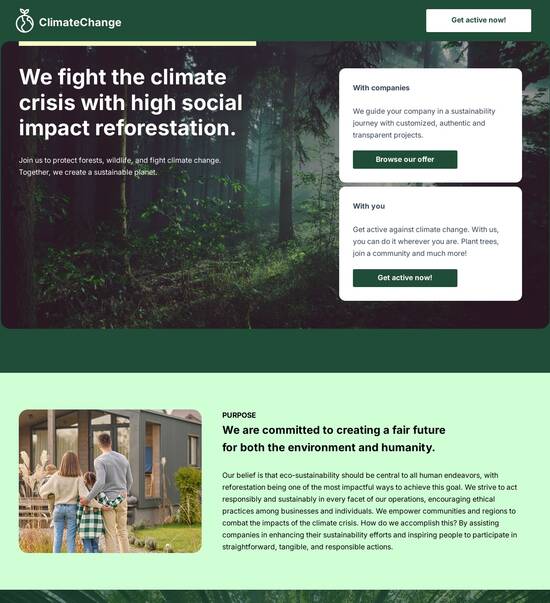
Cross browser HTML page templates
Use TemplateAbout template
Master the art of web design with cross browser HTML page templates. Transform your business today!
Recommended templates

Easy to build without coding
With the intuitive drag-and-drop builder, anyone on your team can create high-converting pages without any knowledge of code or design. Make enhancements to your landing page with custom widgets using Javascript, HTML/CSS, or third-party scripts.

Multiple layouts for any industry and goal
Select from 500+ landing page layouts built to boost conversions across industry-specific scenarios. Customize them by adjusting fonts, adding images, and generating on-brand content with the AI assistant. Quickly scale with Instablocks® and Global Blocks that you can save, reuse, and update globally.

Loads fast and looks polished on any device
Every template is responsive, which means they present professionally on any device and load blazingly fast with our Thor Render Engine. You can also power them up with Google AMP technology to deliver an unparalleled mobile experience and drive higher conversions.

Robust analytics & experimentation
Get real-time updates and reporting across all your devices, showing the number of visitors, conversions, cost-per-visitor, and cost-per-lead. Launch AI-powered experiments, run A/B tests, and use heatmaps to analyze user behavior, then optimize your landing page to maximize conversions.







Easy to build without coding
With the intuitive drag-and-drop builder, anyone on your team can create high-converting pages without any knowledge of code or design. Make enhancements to your landing page with custom widgets using Javascript, HTML/CSS, or third-party scripts.
Multiple layouts for any industry and goal
Select from 500+ landing page layouts built to boost conversions across industry-specific scenarios. Customize them by adjusting fonts, adding images, and generating on-brand content with the AI assistant. Quickly scale with Instablocks® and Global Blocks that you can save, reuse, and update globally.
Loads fast and looks polished on any device
Every template is responsive, which means they present professionally on any device and load blazingly fast with our Thor Render Engine.
Robust analytics & experimentation
Get real-time updates and reporting across all your devices, showing the number of visitors, conversions, cost-per-visitor, and cost-per-lead. Launch AI-powered experiments, run A/B tests, and use heatmaps to analyze user behavior, then optimize your landing page to maximize conversions.
All the features you need to build lead-generating landing pages
Explore more featuresLearn how to build top-performing landing pages for any goal
FAQs
Leading the way in building high-performing landing pages





An all-in-one landing page and CRO platform for marketers
For marketers aiming to create high-converting campaigns in today's competitive digital environment, Instapage offers the most powerful landing page and CRO platform. With its robust features tailored for various sectors including marketing and advertising, education, and financial services, Instapage ensures that every marketing dollar is maximized, allowing you to optimize your campaigns seamlessly.
Getting started with landing pages
Building landing pages with Instapage is straightforward and user-friendly. Here’s a step-by-step guide to kickstart your campaign:
- Choose from over 100 conversion-focused templates: Instapage provides a wide library of templates designed to convert visitors into leads.
- Utilize Instablocks: These are reusable, customizable page sections that save time and ensuring design consistency across your landing pages.
- Incorporate lead generation elements: Easy-to-use features such as forms and call-to-action buttons can be integrated into your landing pages for maximum lead capture.
Optimize your pages for better performance
Optimization is key in enhancing conversions. With Instapage’s built-in experimentation tools, you can continuously improve your landing pages.
Leverage personalization for targeted campaigns
Personalization can drastically boost engagement and conversion rates. Use dynamic text replacement to tailor your content for different audiences. Additionally:
- Ads alignment: Instapage allows you to align specific ads to unique landing pages, ensuring relevancy.
- Audience metrics tracking: With advanced data tools, monitor how different segments interact with your pages to refine strategies.
- A/B testing: Run experiments seamlessly to compare variations of your pages to find out what works best.
Collaborate efficiently to speed up production
Collaboration features within Instapage streamline the page design and approval process. You can easily gather feedback and make real-time edits. Consider these:
- Instant feedback: Provide comments directly on your landing pages, ensuring clear communication.
- Real-time page edits: Collaborate with your team instantly, eliminating the back-and-forth delays in traditional workflows.
- Secure sharing: Share your pages with clients or stakeholders safely to gather insights without risking sensitive information.
By utilizing Instapage's capabilities, you create a streamlined process that enhances your marketing efforts and boosts conversion rates effectively.
Start optimizing your digital marketing campaigns today with Instapage. Sign up now to experience the transformative impact of powerful landing pages!
People also ask about Cross browser HTML page template
Cross Browser HTML Page Template: A Comprehensive Guide
Understanding cross browser compatibility
Cross browser compatibility refers to the capability of a website to function correctly across different web browsers. Each web browser interprets HTML, CSS, and JavaScript's coding differently, which can inadvertently lead to variations in how a webpage is displayed. Ensuring that web pages look similar on various browsers is crucial for maintaining a consistent user experience. In context, HTML templates play a significant role in achieving cross browser compatibility, serving as a foundational structure that adheres to accessibility standards.
The significance of using cross browser compatible HTML templates lies in their ability to cater to the diverse user base that utilizes different browsers. With varying interpretations of web code, having a standardized template can minimize discrepancies, ensuring that a website remains user-friendly across the platforms.
Definition of cross browser compatibility.
Importance of HTML templates in meeting accessibility standards.
Types of browsers
Popular web browsers include Chrome, Firefox, Safari, and Edge, each with its market share and technical specifications. While browsers strive to adhere to web standards, there are fundamental differences in rendering HTML and CSS. For instance, Chrome is known for its speed and extensive developer tools, while Firefox provides robust privacy protections. Safari has optimizations tailored for Apple devices, reflecting its unique functionality. Edge, the newest contender, attempts to bridge the gap by offering compatibility features that appeal to modern web developers.
These varying characteristics impact how HTML and CSS are interpreted. Consequently, developers must test their designs rigorously across these different platforms. This variance reinforces the necessity for solid cross browser HTML page templates that are designed with these differences in mind.
The foundation of HTML page templates
An HTML page template is the basic structure of a webpage defined by HTML code. The primary segments of an HTML template include the head, which contains metadata and links to stylesheets, and the body, which encompasses the visible page content. Key components within a typical HTML page template include the header, footer, and main content area, each serving a distinct purpose in layout and navigation.
A well-structured template not only organizes the content but also establishes a uniform look and feel across different pages of a website. This uniformity is critical when working on themes or styles that adhere to branding and marketing objectives. Furthermore, as HTML specifications evolve, modern templates should integrate these updates to facilitate optimum performance.
Foundation of HTML structure (head and body).
Common elements: header, footer, main content.
Key features of a cross browser HTML page template
A cross browser HTML page template incorporates several key features that enhance its functionality. One critical feature is responsive design, ensuring that web pages adjust their width and layout for various devices and screen sizes. With the increase in mobile usage, responsive design is no longer optional; it is essential for maintaining usability and visual appeal.
Another important aspect is the use of semantic HTML, which enhances accessibility for users with disabilities and improves search engine optimization (SEO). Tags that convey meaning, such as and , provide search engines with better insights into page content. Additionally, leveraging CSS frameworks, like Bootstrap or Foundation, can promote styling consistency across different browsers, reducing the risk of discrepancies.
Benefits of using cross browser HTML page templates
Implementing cross browser HTML page templates brings numerous benefits that improve user experience. Consistent visuals and functionality across different browsers are paramount, as users are likely to abandon a site that looks broken or functions poorly. This uniformity not only fosters trust but also has a direct impact on user retention and conversion rates. When users know they can expect the same high-quality experience regardless of their choice of browser, they are more inclined to engage and return.
Additionally, a streamlined development process is a significant advantage of using these templates. By reducing the time spent on debugging browser-specific issues, developers can focus on enhancing other aspects of the website. This not only fosters a more efficient workflow but also enhances collaboration as teams can share and utilize the same template, aligning their development efforts.
Enhanced user experience.
Streamlined development process.
Improved accessibility for diverse user groups.
Techniques for ensuring cross browser compatibility
Modern web technologies such as HTML5, CSS3, and JavaScript offer several advantages when it comes to creating cross browser compatible websites. These technologies support a range of features designed to optimize performance and accessibility. For instance, HTML5 makes it easier to incorporate rich media and improve the user interface, while CSS3 allows for advanced styling and layout options. Employing progressive enhancement techniques means starting with a basic, functional design that works for all users and adding more elaborate features based on the capabilities of browsers.
Additionally, demonstrating graceful degradation means that while the site may look different across browsers, the core functionality remains intact. This ensures that users, irrespective of their browser choice, have a practical experience. Utilizing testing tools like BrowserStack and Sauce Labs can further solidify cross browser compatibility by enabling thorough testing across different browsers and devices during the development process.
Overcoming common cross browser challenges
One common hurdle in achieving cross browser compatibility is CSS rendering issues. Different browsers may interpret CSS properties and styles inconsistently. For example, the way margin collapsing or flexbox behaves might differ among browsers, leading to design discrepancies. Developers can resolve these issues by employing CSS resets to neutralize browser inconsistencies and by using well-supported, standardized properties.
Another significant challenge arises from JavaScript compatibility. Each browser may have specific implementations that could result in certain features malfunctioning. Utilization of polyfills—JavaScript code that implements the functionality of a feature in older browsers—can help bridge these gaps. On top of that, using frameworks like jQuery can simplify cross-browser JavaScript implementation.
CSS rendering variations among browsers.
Solutions for CSS bugs.
JavaScript compatibility and polyfills.
Handling email clients
When focusing on HTML emails, cross browser compatibility takes on additional challenges, as different email clients render HTML and CSS differently. Outlook, for example, blocks CSS styles and relies heavily on inline styles, while Gmail strips certain CSS attributes altogether. To create HTML email templates that maintain consistent designs across various clients, it is crucial to employ responsive, table-based layouts as more complex styling may not render properly.
Additionally, testing emails across a range of clients and devices can help identify discrepancies early. Tools like Litmus or Email on Acid allow developers to see how their email templates will look across many platforms, providing valuable insights for adjustments. Following these practices ensures a functional and aesthetically pleasing email experience for all recipients.
Best practices for developing cross browser HTML templates
Establishing compatibility standards is essential when creating cross browser HTML templates. Teams should define clear expectations and objectives regarding the templates’ performance, including specific browsers and functionalities that must be supported. This also involves incorporating inclusive design principles right from the outset of the project, allowing for broader accessibility features that cater to diverse audiences.
It is also vital to optimize content for different environments, ensuring pages load quickly and run smoothly regardless of connection speed. Techniques like asset management (e.g., compressing images and minimizing CSS/JS files) will contribute to faster load times. Additionally, providing fallback options for unsupported features ensures that even if users experience issues, they will still access essential content.
Community insights and tools for collaboration
Engaging with developer communities can be a valuable asset for refining cross browser HTML templates. Platforms such as forums and GitHub offer resources for support, guidance, and collaboration. Members of these communities often share insights and best practices that can significantly aid in troubleshooting issues and improving template designs. Cultivating this type of resource-rich environment helps developers stay informed about evolving standards and technologies.
Additionally, tools like Figma and InVision facilitate collaborative design processes. These platforms allow teams to efficiently work jointly on template design, enabling instant feedback, real-time edits, and effective project sharing. Leveraging these tools can streamline workflows and enhance the overall quality of cross browser HTML templates.
Real-world applications and case studies
Several brands have successfully implemented cross browser HTML templates, reaping substantial benefits. For example, a leading e-commerce retailer improved its conversion rates by 30% after switching to a more responsive and compatible template. This change resulted in a noticeable decrease in bounce rates and an increase in customer satisfaction, demonstrating the essential role of cross browser compatibility in driving business outcomes.
In the tech industry, companies that adopted HTML templates focused on user experience reported higher engagement levels in their web applications. By emphasizing compatibility across all common browsers, they established a consistent brand presence and enhanced user trust. These case studies serve as powerful examples of how effective cross browser HTML page templates contribute to improved performance and user satisfaction.
Case studies of successful implementations.
Statistical evidence of success attributed to compatibility.
Addressing common questions and concerns
Many developers have inquiries regarding cross browser HTML templates, such as best practices for maintaining compatibility or misconceptions about browser differences. A common myth is that simple HTML pages will render identically on all browsers, while in truth, variances can arise from even minor HTML structure differences. Educating developers about browser behavior and the significance of testing can equip them to craft more robust templates.
Future trends in cross browser development emphasize the importance of understanding evolving user expectations and technological advances. As user base diversifies and the web landscape continues to change, staying ahead of these shifts will be paramount for maintaining compatibility and relevance. Developers should be prepared to adapt their approaches as new techniques and tools emerge within the industry.
FAQs around the topic.
Myths about browser differences debunked.
Conclusion of insights
Cross browser HTML templates serve as a crucial aspect of web development, fundamentally impacting user experiences across various platforms. By understanding the importance of compatibility, developers can significantly enhance the efficacy of their web designs. The overarching benefits of consistent user experiences, efficient workflows, and improved accessibility underscore the necessity of these templates.
As technology continues to evolve, so too must the strategies employed for cross browser development. A commitment to learning and adaptation will ensure developers maintain the capabilities needed to meet diverse user needs and expectations. Investing in robust and flexible HTML templates will pay dividends in establishing a reputable online presence.
Ready to skyrocket conversions?
Supercharge your ad campaigns with high-performing landing pages
Get started














